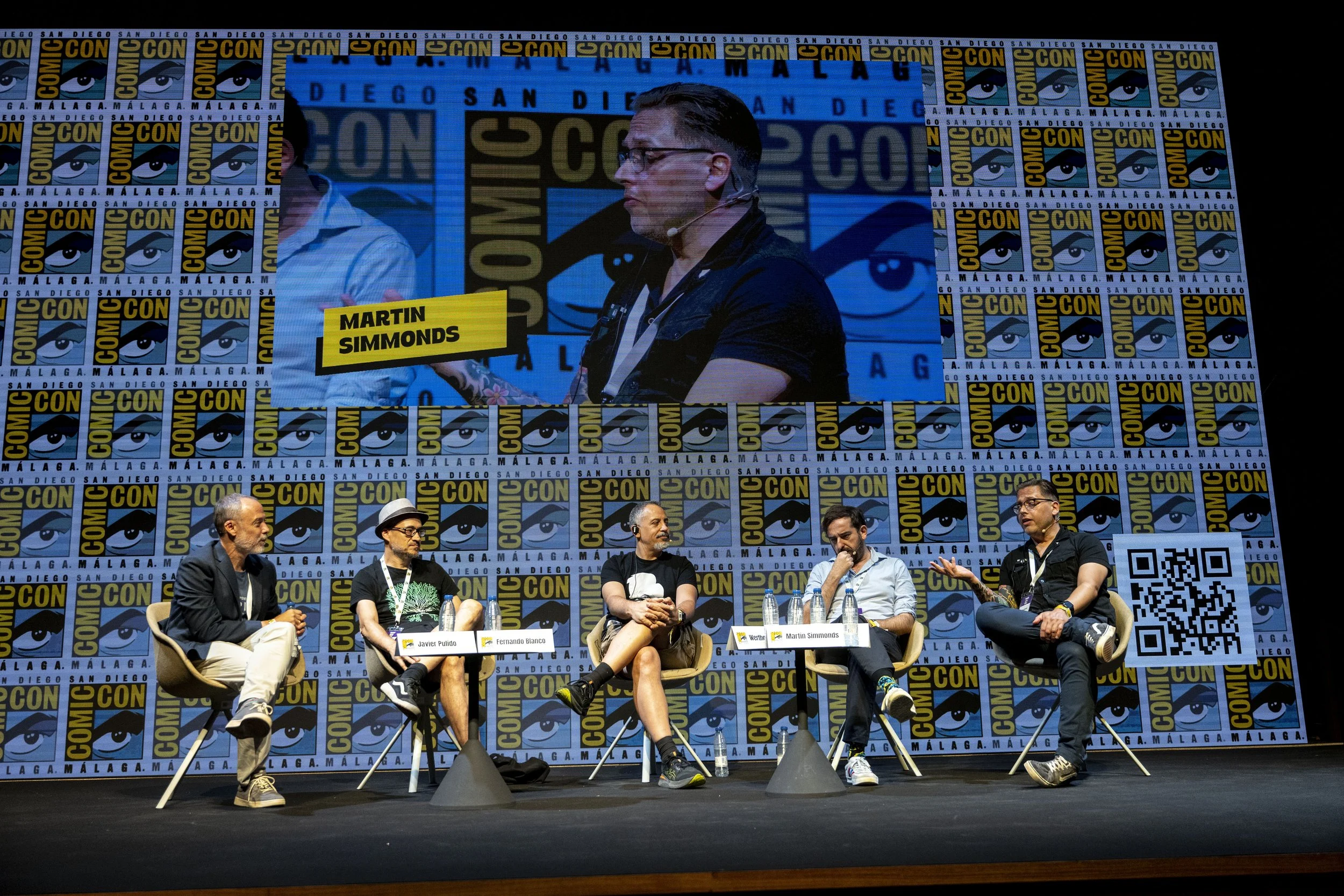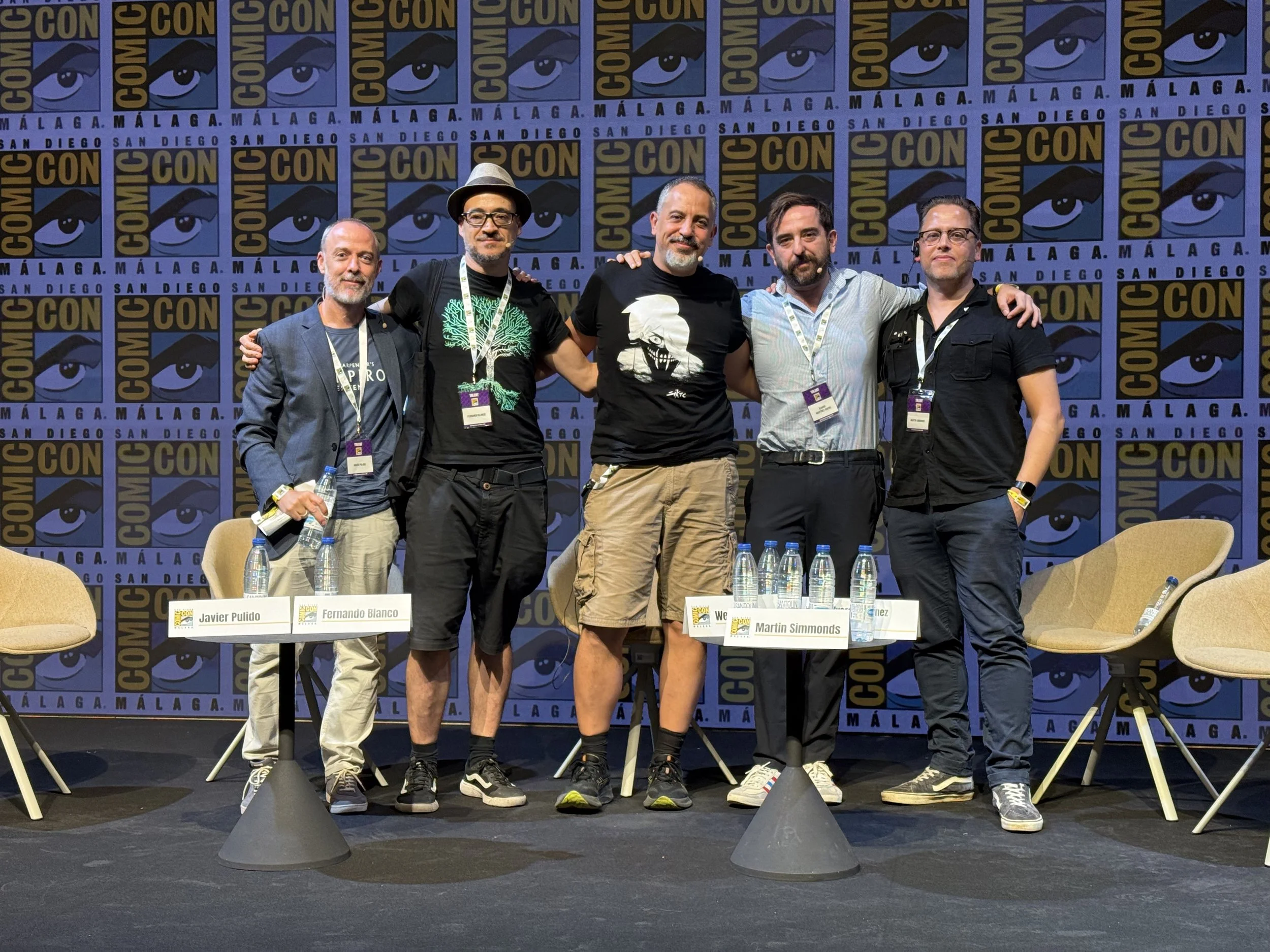The Reinvention of Fear in Comics at SDCC Málaga
Written by Rossano D’Angelo
SDCC Malaga 2025 brought to the fans coming from all over Europe an extensive agenda of events and panels and, among these, we attended The Reinvention of Fear: Contemporary Horror in Comics, which featured four major figures in horror comics sharing their experiences and insights about their work in the industry.
The panel, moderated by Javier Pulido, hosted Fernando Blanco, Werther Dell’Edera, Álvaro Martínez Bueno and Martin Simmonds. The most attentive readers might have noticed a common denominator that brings them together: they all have worked (and still do!) with the superstar of horror comics, writer James Tynion IV.
This panel discussed the relationships with the horror genre, how the panelists implemented horror in comics, and their various connections with Eisner Award winning writer, James Tynion IV.
Javier Pulido: What is your relationship with the horror genre? Have you always been fans of it?
Fernando Blanco: “I never really considered myself a horror fan. I enjoy some horror movies, especially certain directors, but I never thought horror was a genre I could fit into. Honestly, I think it’s James (Tynion IV) who pulled me into it. Surprisingly, I found it fun and natural - maybe because there’s something broken inside me (jokingly). But I realized I feel comfortable drawing horror.”
Martin Simmonds: “I’ve always loved horror, though I think the most frightening things are those that happen in real life. What I love about horror in comics - or any medium - is how it brings out extreme emotions that other genres don’t. It’s not limited to ‘horror books’; you can find it in thrillers, mysteries, even dramas.”
How does horror work differently in comics compared to film or other media?
Martin Simmonds: “In comics, the pacing belongs to the reader. You control when you turn the page, and that makes tension completely different from cinema. The jump scare, for example, becomes a visual trick - a page turn or panel reveal. That’s a fascinating challenge unique to comics.”
Álvaro Martínez Bueno: “Comics and movies are completely different languages. They don’t really overlap well. Sometimes one influences the other, but they stay separate. Movies still dominate popular culture and shape people’s tastes, but comics create a more personal and intimate relationship with the reader.”
What makes working with James Tynion IV special for you?
Werther Dell’Edera: “Working with James is something unique. His scripts are always so well written - especially the dialogue - that I immediately feel immersed in. We’ve done over 40 issues of Something Is Killing the Children, and every new script still feels like the first. Over time, we’ve built a real trust: his scripts now have fewer descriptions, just dialogue, because he trusts my storytelling choices. It’s a true partnership.”
Martin Simmonds: “When James and I started The Department of Truth, we didn’t know each other. By issue three, we’d already developed a kind of shorthand. He began giving me scripts with minimal direction - just dialogue - and that’s when our collaboration really clicked. There’s a lot of freedom and mutual trust, and that’s where the magic happens.”
Fernando Blanco: “Working with James feels natural. He pushes us into dark places but always gives us freedom. It’s inspiring to work with someone who understands horror so deeply.”
Martin Simmonds (jokingly): “James is the one with the twisted mind. He’s the one who really loves horror - we just help him bring it to life.”
How do you keep a long horror series visually fresh without becoming repetitive?
Werther Dell’Edera: “That’s a real challenge. When deadlines are tight, you risk repeating yourself. But I always try to keep things new. Sometimes simplifying my style helps. Working digitally has made me faster and allowed me to stay expressive while experimenting more.”
Martin Simmonds: “The Department of Truth was supposed to last 15 issues, then 30, and now at least 50. Keeping it visually interesting is tough, especially with dialogue-heavy scenes. I rely on contrast - quiet pages followed by something shocking or surreal. That rhythm keeps the reader engaged.”
How explicit should horror art be? Is it better to show or to suggest?
Álvaro Martínez Bueno: “Reading is an internal experience - it happens inside your mind. When you read a comic, you form a bond with the story, and your imagination fills in the blanks. So I don’t worry too much about being overly graphic or explicit. The reader’s imagination will always make it scarier than anything I could draw.”
Martin Simmonds: “Sometimes abstraction or distortion can unsettle the reader more than gore. In The Department of Truth, I use loose, impressionistic lines and color contrasts to make things feel slightly off. That sense of ambiguity is what creates unease.”
What do you think defines modern horror in comics today?
Fernando Blanco: “For me, it’s about emotional honesty. Horror today isn’t just monsters - it’s trauma, fear of change, fear of reality itself. That’s what makes it powerful.”
Werther Dell’Edera: “It’s also about collaboration. The new wave of horror comics exists because of this trust between writers and artists - especially with someone like James, who lets us explore fear in different forms.”
Álvaro Martínez Bueno: “Contemporary horror is introspective. It looks inward rather than outward. It’s about what scares us as people, not just what’s scary to look at.”
Photos are a combination of SDCC Málaga press team and the author of this article.


